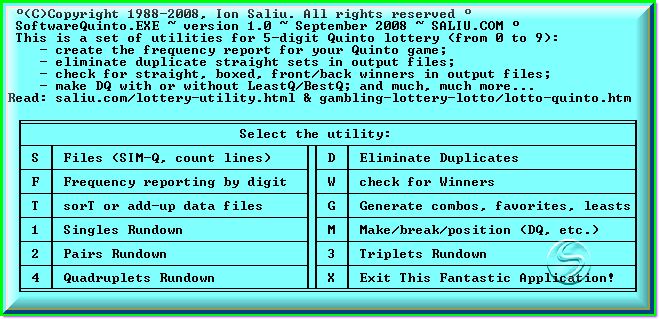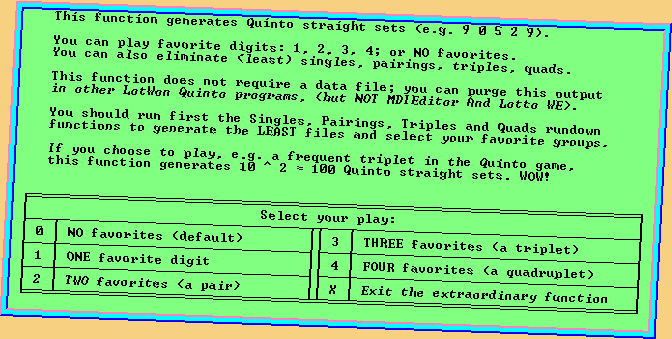
Special Lottery Utility Software for 5-digit Quinto (Pick 5) Lottery Games
By Ion Saliu, ★ Founder of Quinto Pick5 Lottery Mathematics



• SoftwareQuinto:
~ Special lottery utility software for the 5-digit Quinto (Pick 5) lottery game;
~ Updated Rockober 9, 2008; version 1.1; perfected the calculation of probability and FFG median for all digit groups.
This lottery game was introduced by the Pennsylvania State Lottery Commission in August of 2008. There are other games with the same name, but I found out they
refer to a 5-number lotto game, not the 5-digit lottery game as I refer to here.
Quinto draws five digits from 0 to 9 for a total of 100000 straight sets. The top prize is US $50,000. Therefore, the house edge is still a whopping 50%. Nevertheless, Quinto is one of the best lottery games around regarding the size of the first prize and the house edge. A lotto 5/43 game in PA offers a jackpot of $125,000, but the odds are 962598. Thus, the house edge is around four times better playing the Quinto game! Granted, the lotto games have rollovers, with higher and higher jackpots. Larger jackpots, like in the Powerball-type of lotto games, diminish the house edge overall.
For the bulk of the functions, I will refer you back to the material that presents the entire collection of lottery and lotto utility software:
I will analyze here mainly the new functions: the Rundown functions and the Combination generating modules. First, let's take a peek at the main menu.

Programming Quinto software is more difficult than programming lotto games, in some regards. Quinto is a form of exponential sets (Ion Saliu sets). The lotto games consist of combinations, a sub-set of exponents. The exponential sets can have duplicate elements (digits). The position of each element is also of the essence. The lotto combinations consist of only unique elements (numbers); the position of the elements in the combination is not of the essence.
The boxed parameter in SoftwareQuinto is the largest block of source code in my entire lottery or lotto software. That includes Powerball, Mega Millions, and Euromillions software. The Quinto boxed is also one of the most difficult probability parameters to comprehend and figure out the programming code.
I thought SoftwareQuinto would be easier to program than any lotto software. Actually, it was harder. Fortunately, the huge library of my previous programming helped a lot. Still, I needed mathematical discoveries to carry out the goal of writing Software Quinto.
No wonder there is NO other comparable software for digit lotteries. It appears that I am the only one who is able and apt to write software for the Ion Saliu sets. That great program, PermuteCombine, is still unique…after all those turbulent years (since the year of grace 2003, when Octavianus Augustus was granted tribunicia potestas).
As I said, I came across mathematical discoveries. The most important flashes of creativity were related to the Fundamental Formula of Gambling (FFG) and its fundamental elements: Probability (p), degree of certainty (DC), and number of trials (N). The number of trials N had given me some problems in establishing the range of analysis for the lottery wonder grid. I had tried lots of ranges, or number of past drawings to analyze. In order to simplify, I introduced the concept of parpaluck. It is simpler to say or write than number of past drawings to analyze!
Programming Software Quinto helped me determine precisely the parpalucks for any probability, degree of certainty and number of trials. If the degree of certainty is 50% (the FFG median), then the parpaluck must output half of the elements, while half of the elements are still idle. SoftwareQuinto does exactly that for single digit groups, pairs (pairings), triples, quadruples, and even quintuples (the straight elements).
The singles, pairs (pairings), triples, quadruples, quintuples, etc., are the primordial lottery filters. Other filters, such as Ion1 to Ion5, Bun, Ver, Any, Pairs, Syn, Deltas, etc. are derived filters. The primordial filters are immediately derived from FFG. The derived filters, which have a minimum and a maximum level, necessitate a second step of applying the Fundamental Formula of Gambling.
See all types of sets in Pick-5 (Quinto): Singles, 1 double + 3 singles, 2 doubles + 1 single, 1 triple + 2 singles, 1 triple + 1 double, 1 quadruple + 1 single, quintets:

• The Rundown functions perform statistical analyses of single and multiple digit groups in the Quinto (Pick 5) games. The groups are:
~ singles: one Quinto digit at a time, of course!
~ pairings: 2-digit Pick5 groups;
~ triplets: 3--digit Quinto groups;
~ quadruplets: 4-digit Pick-5 groups.
You already saw the statistical reports for the triplets and the quadruplets in the total freeware (the ToolsLotto software). The programs determine the span of analysis or parpaluck for each number group. The span of analysis is calculated by the Fundamental Formula of Gambling (FFG). It represents N (number of past lottery drawings) for a degree of certainty DC = 50%.
The quadruplets require quite large data files. Virtually no lottery has ever conducted that many Quinto drawings. It's a baby game, by George! It would be great to have lots of real draws! Still, we can use those free SIMulated data files that this very application creates itself with ease. You can try to generate the reports for the triplets, quadruplets by using your DQ files..
Again, it is not exactly like using real data files, with actual Quinto Pick 5 drawings. On the other hand, the lottery commissions always run fake drawings. That is, they conduct a number of drawings, before the real one (the draw or result they publish). Nonetheless, my tests clearly show that there is no mathematical difference between actual drawings (as conducted by the state commissions) and simulated draws (as generated by great computer software, such as the one created by yours truly). My Quinto real data file has 28 draws. The parings filter requires 7 drawings for a parpaluck corresponding to the FFG median. As calculated by undeniable mathematics, half of the elements (Pick-5 pairs) came out; half of them have not. The triplets filter requires 69 drawings for a parpaluck corresponding to the FFG median. I needed to use simulated Quinto sets. As calculated by undeniable mathematics, half of the elements (Pick 5 triples) came out; half of them have not. QED.

• • Lets look now at the modules that generate Pick 5 straight sets, with or without favorite digits, eliminating the least groups or not.

This new straight sets generating function has 5 subroutines:
1) Generate Quinto straight sets with NO favorite digits;
2) Generate Pick 5 straight sets with ONE favorite digit;
3) Generate Quinto straight sets with TWO favorite digits (a favorite pair);
4) Generate Pick5 straight sets with THREE favorite digits (a favorite triplet);
5) Generate Pick 5 straight sets with FOUR favorite digits (a favorite quadruplet).
Each subroutine has its own multiple choices:
1.- do not eliminate any least frequent groups;
2.- eliminate the least singles;
3.- eliminate the least (worst frequent) pairings;
4.- eliminate the least triplets;
5.- eliminate the worst quadruplets.
Nota bene. There is a strategy error regarding the LEAST functions. Do NOT use the combination generators with the LEAST options in SoftwareLotto6! Always press N or n to disable the LEAST options!
The singles elimination has some powers, nonetheless. In a Quinto lottery game, the singles elimination (LeastQ1) generates 1024 straight sets (down from 100000). Indeed, other least groups are even more potent; e.g. 'least pairs' generates around 100 combos, without favorite digits. Playing 2 favorite Pick-5 digits and eliminating the 'least triples' generates only 4 straight sets, sometimes only 1...most of the time zero, zilch, none!
Be mindful of synchronicity, too. You may choose a favorite digit and try to generate combos by eliminating the least singles. If your fave is among the entries in LeastQ1, the software will not generate one...single lottery set...of course!
Only the full version of Software Pick5 enables the full Quinto lottery combination generators. The kicker: Those applications will be fee-based. Such power deserves much more than that meager membership fee to download my free software. The full version, that I have the luxury to work with in some advanced beta, generates, sometimes, just one straight Pick 5 straight set. Of course, the skips and streaks have an important role to play. The winning reports are still on the drawing board.
Very important! The Least Pairings are calculated differently in the Frequency function and the Pairings Rundown module. The Break/Position combination generating functions work correctly with the LEAST file created by Frequency. It is spelled LEASTq. The Pairings Rundown module creates a file named LeastQ2.
Also, the favorite number feature requires favorite digits in exact order. This feature is synchronized with the Rundown functions and assures maximum efficiency. You will notice that, for example, the pair 1-2 has a high frequency, while 2-1 has not yet come out.
Something else to keep in mind: This software is not distributed on a definitive basis. The two programs might be withdrawn without notice. You might have seen quite a few pages at this web site with the header 'Offer withdrawn'. If you are a member, I warmly recommend you visit the software download page. Then, start the download ASAP. Keep good records of your membership and also the downloading of this Quinto lottery title. If the full version released, only registered members would be eligible.

Resources in Lottery Software, Strategies, Lotto Systems
See a comprehensive directory of the pages and materials on the subject of lottery, lotto, software, systems, and wheels. The link is displayed in a new window

Home | Search | Help | New Writings | Software | Odds, Generator | Contents | Forums | Sitemap
